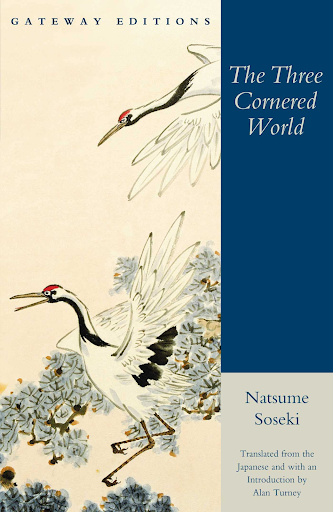
The Three Cornered World by Natsume Soseki is narrated in the first person by an artist who stops by a village for a period of time after being stopped by the rain on his hike. During this time, he looks to produce art, ideally a painting, though he composes many poems and sketches along the way. Throughout the narrative, the artist (who I just now realized is never named) provides musings on what it means to be an artist and what goals he should strive for, coming across as slightly sanctimonious at times. His namelessness may point to his general representation of an artist, or perhaps a name was simply deemed unnecessary by Soseki. At times, the book is very plainly instructive, as the narrator shares what he believes makes art beautiful. He references examples of western art as well as Chinese and Japanese art, from novels to paintings to poems to calligraphy. He reflects on each one and their virtues. Eventually one cannot help but wonder how many of these thoughts are those of the young ambitious character’s or of Soseki’s own.
As part of his stay in the village, he meets many people and shares enlightening conversations. He discusses calligraphy with a family, art with a monk, and also acquaintances himself with a girl who shares a likeness with one from a legend that occurred in the town who has an interesting life of her own.
Apart from the ideas expressed in the novel, the prose is truly remarkable. Many times I annotated (which is decently rare for me, even when teachers require it, but I couldn’t help it here) how the description seemed out of a movie, often due to the narrator’s attention to the light and shadow in a scene. Perhaps I was influenced by the back cover’s description that the book “offers the reader an exquisite ‘word painting,’” but it certainly does seem that way at times, with each carefully chosen sentence akin to a brushstroke in an impressionist masterpiece. It is further bolstered by the poems the narrator writes to capture it. For instance, he describes the unique serenity of the view outside his window at one point, then attempts to capture it in the form of a haiku. He provides his own commentaries and critiques, as any artist does, and although neither may not be the perfect encapsulation, they compliment each other very well and certainly evoke the feeling he intended. Between his poetry and the prose of the story, the novel is exceptionally beautifully written, and I wonder how much more was lost in translation.
Between the subject and the writing, The Three Cornered World is unlike any other book I’ve read. It can be extremely thought-provoking if one wishes to entertain a dialogue with the narrator, for I did find some of his claims to be disputable. As such, it offers a different form of entertainment than most other books offer. I would venture to place this book in my top three favorites, along with (in no particular order, since they are all so different) To Kill a Mockingbird and The Boy, the Mole, the Fox, and the Horse.

